Eucalyptus Leaf Beetle - Chrysophtharta cloelia
FAMILY CHRYSOMELIDAE
This page contains information and pictures about Eucalyptus Leaf Beetles that we found in the Brisbane area, Queensland, Australia.
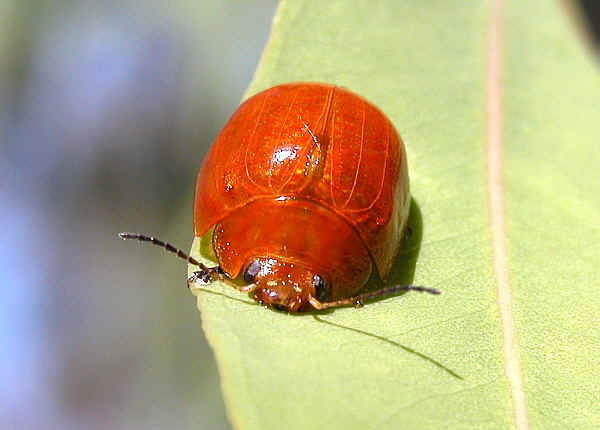
- Body length 8mm
- This Leaf Beetle are sometimes found on young Eucalyptus trees in Brisbane forest from late spring to summer. They are golden brown in colour. They can be found resting on leaves or stems. When approached, they will drop onto the ground.
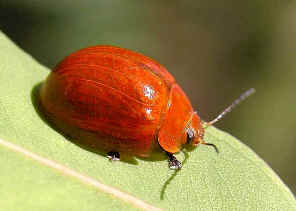
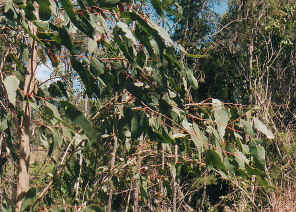
-
- Notice in the second picture almost every leaves have the Leaf Beetles' bite marks. Both adults and larvae feed on Eucalyptus leaves, however, larvae consume much most than the adults. Larvae feed mostly on the new shots and eat all the entire young leave. Adults mainly target on the edges of older leaves and leave bite marks
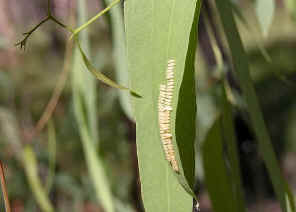
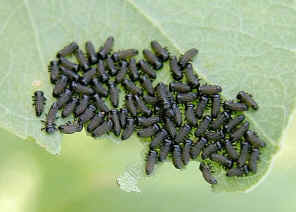
- Eggs, 1mmx3mm 1st instars, 3mm
- Females lay eggs on young leaves. Newly hatched larvae are black in colour. They start feeding in group on young leaf. They feed from leaf tip to base.
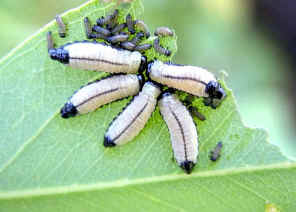

- 2nd instars and last instars Larvae length 5mm
- The later instars are creamy colour with black head. They may feed individually or in group. In the second picture above all larvae was rearing the head and abdomen. It is their defense behavior. By doing this, the larvae release the eucalypt oil with hydrogen cyanide from their glands. Those chemical can kill other insects, such as ants.

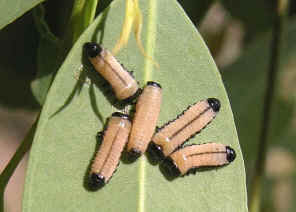
- Larvae length 8mm Larvae length 12mm
- Fully developed larvae move down the tree to pupate in the soil.
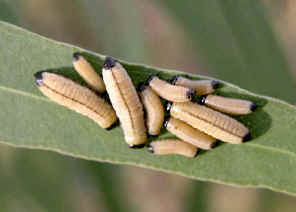
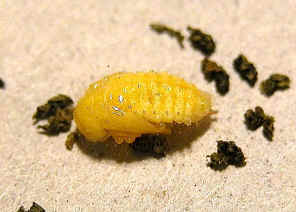
- Larvae length 8-12mm Pupa length 6mm
- In a early summer day, we found a group of small white larvae on a Eucalyptus leaf. We looked around and found that almost on all the leaves of the young Eucalyptus have some larvae feeding. We know those larvae are Chrysophtharta sp., and we wanted to know how their adults look like. We took some leaves and some larvae home and put them in a jar. Few days later, the larvae turned into pupae.
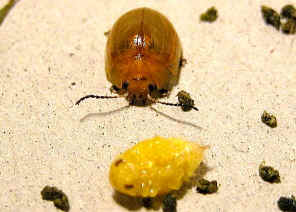
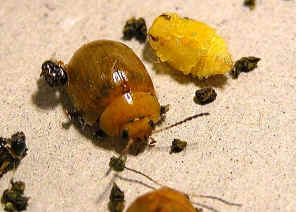
- One weeks later some pupae turned into adults. In the field, we do not normally see those pupae because they drop onto the ground and hide in the plants litter before pupation.
- Notice in the second picture almost every leaves have the Leaf Beetles' bite marks. Both adults and larvae feed on Eucalyptus leaves, however, larvae consume much most than the adults. Larvae feed mostly on the new shots and eat all the entire young leave. Adults mainly target on the edges of older leaves and leave bite marks
The Leaf Beetle Nature Enemies
- We found the following nature enemies of this Leaf Beetle species. We
believe those nature enemies are common for most of the Leaf Beetles.
- Parasite Wasp
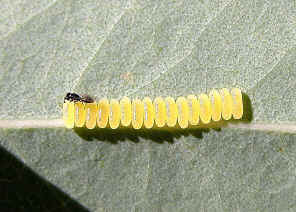
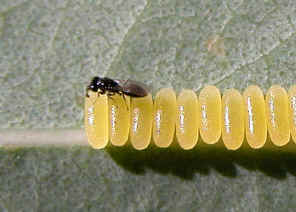
- Wasp body length 3mm
- We found that the Leaf Beetle eggs were heavily parasitised by the tiny parasitic wasps, especially from mid to late summer season. The batches of Leaf Beetle eggs that we collected in late summer season are all parasitised. There are more information on Leaf Beetle eggs parasitoids in this section.
- Tachinid Fly


- Fly body length 7mm
- The above pictures show a Tachinid Fly checking the Leaf Beetle Larvae and about to lay eggs on the larvae. The white eggs of the fly are attached on the body of the larva. The egg hatches into maggot and bores into the body of the Leaf Beetle larva, develops inside and kill the larva.
- Glossy Shield Bug

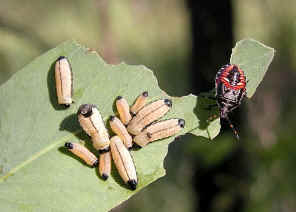
- On the gum tree that we found those Leaf Beetle adults and larvae, we also found a few Glossy Shield Bug nymphs wandering on stems looking for their prey. The Predatory Shield Bug prey on all kinds of soft body insects including caterpillars and Leaf Beetle Larvae.
- Spined Predatory Shield Bug
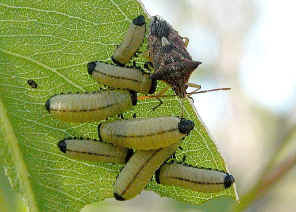
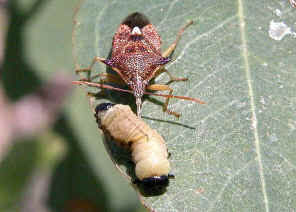
- The Spined Predatory Shield Bug is also a common predator of the Leaf Beetle larvae. In mid-summer, we saw a young gum tree in Karawatha Forest which was heavily infected by the Leaf Beetle Larvae. However, near every group of feeding beetle larvae, there was a Spined Predatory Shield Bug attacking them.
